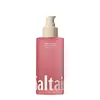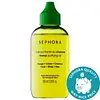What's inside
What's inside
 Key Ingredients
Key Ingredients

No key ingredients
 Benefits
Benefits

 Concerns
Concerns

 Ingredients Side-by-side
Ingredients Side-by-side

Carthamus Tinctorius Seed Oil
MaskingRicinus Communis Seed Oil
MaskingCaprylic/Capric Triglyceride
MaskingParfum
MaskingCaryodendron Orinocense Seed Oil
EmollientAleurites Moluccanus Seed Oil
Skin ConditioningSqualane
EmollientLimnanthes Alba Seed Oil
Skin ConditioningPongamia Glabra Seed Oil
Skin ConditioningMoringa Oleifera Seed Oil
EmollientPrunus Armeniaca Kernel Oil
MaskingPlumeria Acutifolia Flower Extract
Skin ConditioningTetrahexyldecyl Ascorbate
AntioxidantEclipta Prostrata Extract
Skin ConditioningMelia Azadirachta Leaf Extract
Skin ConditioningLinoleic Acid
CleansingLecithin
EmollientPhytosteryl Canola Glycerides
Skin ConditioningPalmitic Acid
EmollientOleic Acid
EmollientTriolein
Skin ConditioningTocopherol
AntioxidantStearic Acid
CleansingBenzotriazolyl Dodecyl P-Cresol
UV AbsorberCoumarin
PerfumingHexyl Cinnamal
PerfumingCarthamus Tinctorius Seed Oil, Ricinus Communis Seed Oil, Caprylic/Capric Triglyceride, Parfum, Caryodendron Orinocense Seed Oil, Aleurites Moluccanus Seed Oil, Squalane, Limnanthes Alba Seed Oil, Pongamia Glabra Seed Oil, Moringa Oleifera Seed Oil, Prunus Armeniaca Kernel Oil, Plumeria Acutifolia Flower Extract, Tetrahexyldecyl Ascorbate, Eclipta Prostrata Extract, Melia Azadirachta Leaf Extract, Linoleic Acid, Lecithin, Phytosteryl Canola Glycerides, Palmitic Acid, Oleic Acid, Triolein, Tocopherol, Stearic Acid, Benzotriazolyl Dodecyl P-Cresol, Coumarin, Hexyl Cinnamal
Vitis Vinifera Seed Oil
EmollientDiisopropyl Adipate
EmollientCetearyl Isononanoate
EmollientIsopropyl Myristate
EmollientNeopentyl Glycol Diheptanoate
EmollientTridecyl Trimellitate
EmollientRicinus Communis Seed Oil
MaskingOryza Sativa Bran Oil
EmollientNeopentyl Glycol Dicaprylate/Dicaprate
EmollientParfum
MaskingTaraktogenos Kurzii Seed Oil
Skin ConditioningDiethylhexyl Syringylidenemalonate
Skin ProtectingLimonene
PerfumingCaprylic/Capric Triglyceride
MaskingCannabis Sativa Seed Oil
EmollientVitis Vinifera Seed Oil, Diisopropyl Adipate, Cetearyl Isononanoate, Isopropyl Myristate, Neopentyl Glycol Diheptanoate, Tridecyl Trimellitate, Ricinus Communis Seed Oil, Oryza Sativa Bran Oil, Neopentyl Glycol Dicaprylate/Dicaprate, Parfum, Taraktogenos Kurzii Seed Oil, Diethylhexyl Syringylidenemalonate, Limonene, Caprylic/Capric Triglyceride, Cannabis Sativa Seed Oil
Ingredients Explained
These ingredients are found in both products.
Ingredients higher up in an ingredient list are typically present in a larger amount.
This ingredient is an emollient, solvent, and texture enhancer. It is considered a skin-softener by helping the skin prevent moisture loss.
It helps thicken a product's formula and makes it easier to spread by dissolving clumping compounds.
Caprylic Triglyceride is made by combining glycerin with coconut oil, forming a clear liquid.
While there is an assumption Caprylic Triglyceride can clog pores due to it being derived from coconut oil, there is no research supporting this.
Learn more about Caprylic/Capric TriglycerideParfum is a catch-all term for an ingredient or more that is used to give a scent to products.
Also called "fragrance", this ingredient can be a blend of hundreds of chemicals or plant oils. This means every product with "fragrance" or "parfum" in the ingredients list is a different mixture.
For instance, Habanolide is a proprietary trade name for a specific aroma chemical. When used as a fragrance ingredient in cosmetics, most aroma chemicals fall under the broad labeling category of “FRAGRANCE” or “PARFUM” according to EU and US regulations.
The term 'parfum' or 'fragrance' is not regulated in many countries. In many cases, it is up to the brand to define this term.
For instance, many brands choose to label themselves as "fragrance-free" because they are not using synthetic fragrances. However, their products may still contain ingredients such as essential oils that are considered a fragrance by INCI standards.
One example is Calendula flower extract. Calendula is an essential oil that still imparts a scent or 'fragrance'.
Depending on the blend, the ingredients in the mixture can cause allergies and sensitivities on the skin. Some ingredients that are known EU allergens include linalool and citronellol.
Parfum can also be used to mask or cover an unpleasant scent.
The bottom line is: not all fragrances/parfum/ingredients are created equally. If you are worried about fragrances, we recommend taking a closer look at an ingredient. And of course, we always recommend speaking with a professional.
Learn more about ParfumRicinus Communis Seed Oil is the INCI name for castor oil.
Castor Oil helps moisturize the skin. It is rich in a fatty acid called ricinoleic acid. This fatty acid helps prevent moisture loss on the skin. This helps keep your skin soft and hydrated. Ricinoleic acid also has anti-inflammatory and pain reducing properties.
Besides hydrating the skin, castor oil is also used to hydrate hair. By keeping the hair shaft moisturized, breakage is decreased. More studies are needed to show castor oil's effective on stimulating hair growth.
Castor oil is created by cold-pressing castor seeds and then purifying the oil with heat. It was used in Ancient Egypt as fuel in lamps and to help treat eye irritation.
The term 'fragrance' is not regulated in many countries. In many cases, it is up to the brand to define this term. For instance, many brands choose to label themselves as "fragrance-free" because they are not using synthetic fragrances. However, their products may still contain ingredients such as essential oils that are considered a fragrance.
Learn more about Ricinus Communis Seed Oil